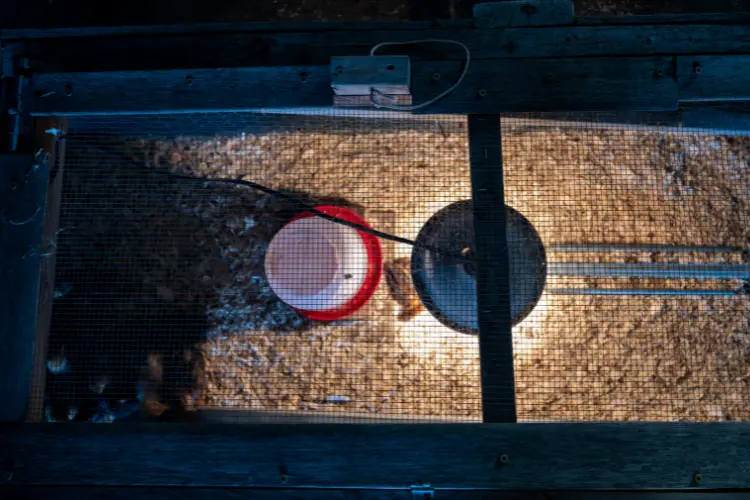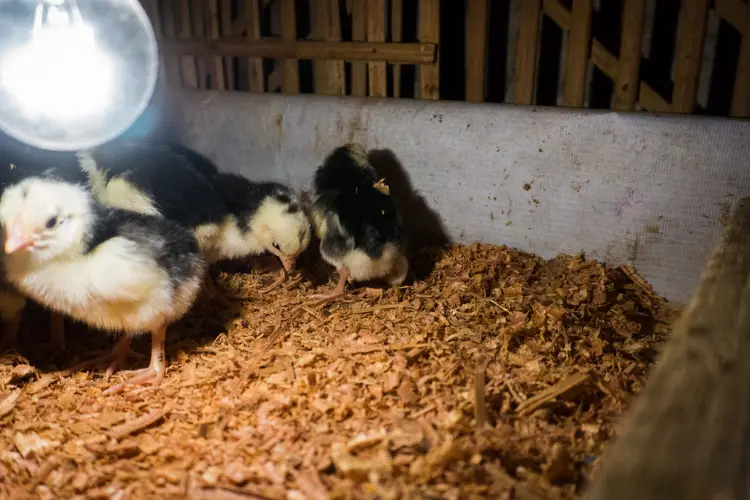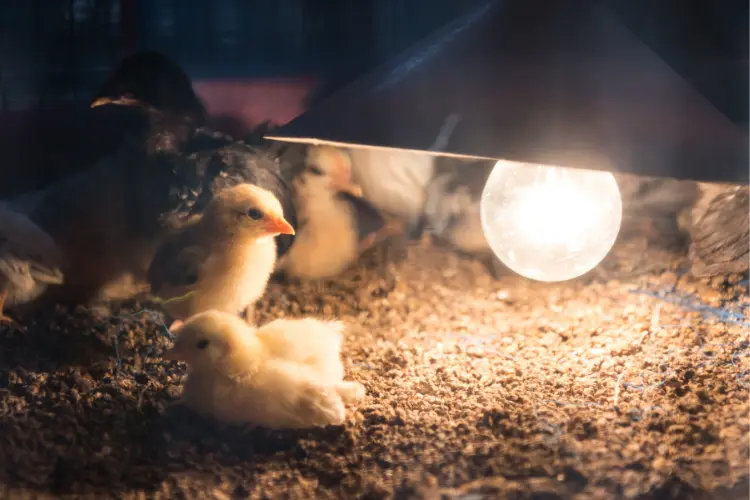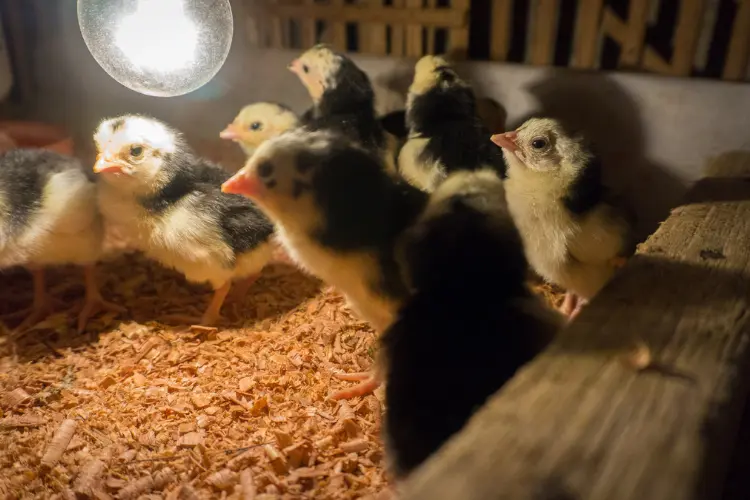How Long Do Chicks Need a Heat Lamp: The Definite Answer
Are you a new chicken owner, excitedly awaiting the arrival of adorable chicks in your backyard? While raising baby chicks can be a rewarding experience, it’s essential to ensure their well-being, especially during their early stages of life.
One crucial aspect of chick care is providing the right amount of heat. But how long do baby chicks need a heat lamp? So, in this guide, we will explore this topic and learn how to care for them to help them grow strong and healthy.
How Long Do Chicks Need a Heat Lamp?
The duration for which chicks need a heat lamp depends on their age and development stage. Generally, chicks require a heat lamp for the first four to six weeks of their lives. During this time, they rely on the heat lamp to maintain their body temperature and stay warm.
However, as they grow feathers and become more independent, they gradually require less heat. It’s important to monitor their behavior and adjust the heat lamp accordingly, gradually reducing the heat until they no longer need it. Proper temperature regulation is vital for the chicks’ health and overall well-being.

Best Temperatures for Baby Chicks
- First week: Keep the brooder temperature around 95 degrees Fahrenheit (35 degrees Celsius) throughout the week.
- Second week: Gradually reduce the temperature to around 90 degrees Fahrenheit (32 degrees Celsius).
- Third week: Lower the temperature to approximately 85 degrees Fahrenheit (29 degrees Celsius).
- Fourth week: Further decrease the temperature to around 80 degrees Fahrenheit (27 degrees Celsius).
- Fifth week: Aim for about 75 degrees Fahrenheit (24 degrees Celsius).
- Sixth week: Finally, maintain a temperature of around 70 degrees Fahrenheit (21 degrees Celsius).
How To Know If Chicks Are Getting Enough Warm?
Active and Engaged
Chicks that are warm enough will be active, moving around, and showing curiosity about their surroundings. They will exhibit normal levels of energy and engage in social behaviors.
Content Sounds
Listen for soft and contented cheeping sounds. If the chicks make calm and relaxed noises, it suggests they are comfortable and warm.
Balanced Eating and Drinking
Warm chicks will have a healthy appetite and regularly drink water. They will actively seek out and consume their feed without signs of lethargy or reduced interest in food.
Comfortable Sleep
When chicks are warm enough, they rest comfortably and appear relaxed while sleeping. They will settle down and sleep without excessive shivering or huddling.
Natural Spacing
Chicks that are warm enough will spread out in the brooder, indicating they are comfortable and not trying to huddle together for warmth or get body heat. They will evenly distribute themselves rather than excessively clustering together.
Signs That Chicks Experience Cold Stress
- If the chicks are excessively clustering together, piling on each other, or trying to squeeze under the heat source, it’s a sign that they are feeling too cold.
- Chicks may start making loud, distressed noises if they feel cold and uncomfortable.
- Cold baby chick may appear weak, sluggish, or less active than usual.
- Cold temperatures can contribute to pasty butt, where droppings stick to the chick’s vent area, leading to blockage and discomfort.
Signs That Chicks Experience Heat Stress
- Chicks that are too hot will exhibit rapid, heavy breathing and may even pant to cool themselves down.
- If the chicks are avoiding the heat source, moving away from it, and trying to find cooler areas in the brooder, it indicates that they are too hot.
- Chicks that are overheated may hold their wings slightly away from their bodies in an attempt to cool down.
- Overheated chicks may appear lethargic, lie down frequently, or sleep more than usual.

Reasons to Use Heat Lamps
Maintaining Optimal Temperature
Heat lamps provide a reliable and adjustable heat source, ensuring that chicks stay within the appropriate temperature range for their growth and development. This helps them regulate their body temperature and stay warm, which is crucial for their well-being.
Promoting Growth and Feather Development
Adequate heat stimulates chick metabolism and digestion, allowing them to efficiently convert food into energy for growth. The warmth also encourages feather development, helping chicks develop the plumage necessary for temperature regulation as they grow.
Enhancing Activity and Movement
Chicks raised in a warm and comfortable environment with heat lamps tend to be more active, lively, and curious. This promotes healthy exercise, exploration, and social interaction, essential for their physical and mental development.
Minimizing Stress and Health Issues
Proper heat reduces stress on chicks, making them less susceptible to various health issues. Maintaining the right temperature range can help prevent conditions such as pasty butt, which can occur when chicks are exposed to colder temperatures.
Facilitating Early Development
The warmth provided by heat lamps supports the proper development of chicks’ internal organs, nervous system, and immune system. This helps build a solid foundation for their long-term health and vitality.
Safety Tips in Using Heat Lamp
- Ensure the heat lamp is securely attached and positioned correctly in the brooder. Use a clamp or other reliable method to prevent it from falling or being knocked over by the chicks.
- Maintain a safe distance between the heat lamp and the chicks to avoid accidental contact or burns. Refer to the manufacturer’s instructions for recommended distances.
- Keep the heat lamp away from flammable materials, such as bedding or curtains. Make sure there are no exposed wires and that the lamp is in good working condition to minimize fire hazards.
- Regularly check the temperature in the brooder using a thermometer to ensure it stays within the appropriate range. This helps prevent overheating or chilling of the chicks.
- Ensure proper ventilation in the brooder area to prevent excessive heat buildup. Good airflow helps maintain a healthy environment for the chicks.
- Use a grounded outlet and ensure the electrical cords are in good condition, without fraying or damage. Avoid overloading the outlet with multiple devices.
- Keep an eye on the chicks and the heat lamp, especially if there are children or pets around. Supervision helps prevent accidents and ensures the chicks’ safety.
- Have a backup heat source ready if the heat lamp malfunctions or power leaks unexpectedly. This could be an extra heat lamp, a heating pad, or a warm water bottle.

At What Age Can Chicks Start Playing Outside?
Chicks can go outside to play once they have grown enough feathers to keep themselves warm and regulate their body temperature. This typically occurs when they are around 4 to 6 weeks old, depending on the breed and weather conditions.
Before letting them outside, ensure that the outdoor temperature is suitable and there are no extreme weather conditions such as rain, strong winds, or excessively cold temperatures. Ensure they will not get bullied by other backyard chickens or adult chickens.
Gradually introduce them to the chicken coop outdoors by providing a secure and supervised space initially, allowing them to explore and gradually adjust to their new environment. Always prioritize their safety and monitor their behavior during outdoor playtime.
When Is It Safe for Chicks to Be Outside without a Heat Lamp?
Chicks can go outside without a heat lamp once they have developed enough feathers to keep themselves warm and regulate their own body temperature. This typically occurs when they are around 6 to 8 weeks old, but it can vary depending on the breed and weather conditions. Monitor the chicks closely during outdoor time to ensure they are comfortable and show no signs of being too cold.
Do Chicks Need a Heat Lamp 24-Hour a Day?
Yes, baby chicks typically need a heat lamp to be provided 24 hours a day during their early stages of life. The heat lamp is a crucial only heat source to keep the chicks warm and maintain their body temperature.
Chicks cannot regulate their body temperature effectively during the first few weeks after hatching, so continuous access to a heat lamp is essential for their well-being. As the chicks grow older and develop feathers, their need for constant heat decreases, and you can gradually reduce the usage of the heat lamp according to their behavior and the surrounding temperature. You can streamline your poultry care processes with poultry automation solutions to enhance efficiency and effectiveness in chick rearing.
Read also: 10 Must-Have Baby Chick Raising Supplies: A Complete List

When Can You Safely Stop Using a Heat Lamp for Chicks?
You can stop using a heat lamp for chicks when they have fully feathered out and can regulate their body temperature effectively. This usually occurs around 4 to 6 weeks of age, but it can vary depending on the breed and environmental conditions.
It’s important to observe the behavior of the chicks during this time. If they are active, exploring their surroundings, and spending less time seeking warmth from the heat source, they no longer need the heat lamp.
Gradually reduce the lamp’s heat over a few days to help them acclimate to room temperature. Ensuring a comfortable ambient temperature in the brooder area is still essential, so monitor the chicks’ behavior and adjust accordingly.
Read also: A Comprehensive Guide to Raising Baby Chicks Week by Week
Alternatives to Heat Lamps
Brooder Temperature
Ensure the brooder box is kept in a warm environment, ideally between 75-85 degrees Fahrenheit (24-29 degrees Celsius). If you’re looking for a reliable and efficient source of warmth, consider the Brinsea EcoGlow chick brooders. These have been redesigned to be safer, more economical, and easier to clean. You can utilize a thermometer to observe the temperature and make necessary adjustments accordingly. You can buy this from feed or pet stores.

Heating Pad
Place a heating pad designed for chicks under one side of the brooder, allowing them to move to a warmer area when needed. Make sure the pad is covered with a layer of bedding to prevent direct contact.
Warm Water Bottles
Fill water bottles with warm (not hot) water and wrap them in towels or place them in the brooder. Chicks can snuggle against them for warmth. This can also be used when you have a sick chick.
Heat Plates
Use a heat plate specifically designed for chicks. These provide a warm surface that mimics the warmth of a mother hen and can be adjusted to different heights as chicks grow.
Cozy Bedding
Provide thick bedding in the brooder to create insulation and retain heat. Pine shavings or straws are good options, ensuring they are clean and dry.
Natural Heat Sources
If weather permits, you can allow young chicks to spend supervised time outside during sunny and mild days, benefiting from natural warmth. Ensure there are shaded areas and protection from drafts.
Conclusion
Understanding how long chicks need a heat lamp is essential for providing optimal care during their early stages of life. The duration of heat lamp usage depends on the chicks’ age, development, and ability to regulate their body temperature.
By closely monitoring their behavior and adjusting the heat lamp accordingly, we can ensure they are warm, comfortable, and on the path to healthy growth. Remember, with the knowledge gained from this guide, you are equipped to provide the best care for your baby chickens and embark on a rewarding journey of raising these adorable feathered companions.




